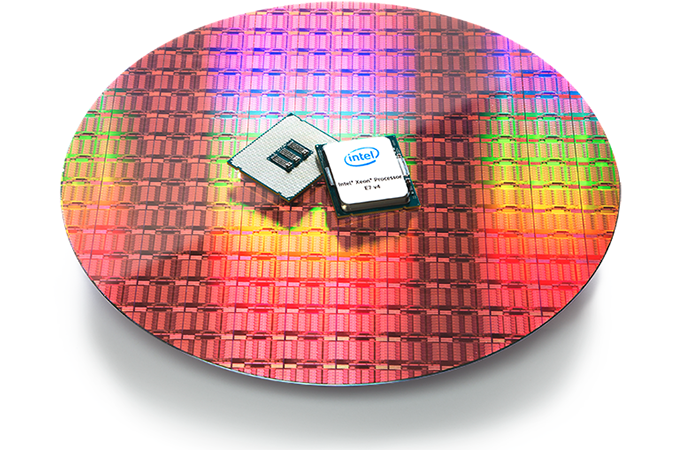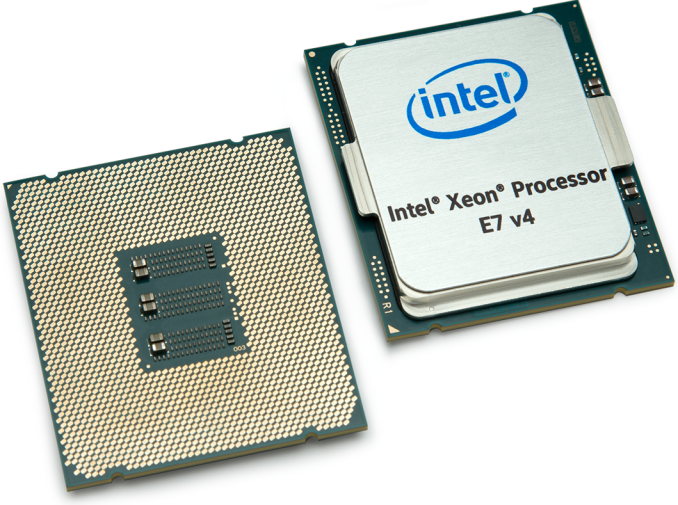Intel Announces the Xeon E7-8894 v4 CPU: 24 Cores at 2.4 GHz for $8898
by Anton Shilov on February 13, 2017 9:00 AM EST- Posted in
- CPUs
- Intel
- Xeon
- Servers
- Broadwell-EX
- E7-8894 v4

In the past week, Intel has launched a new halo CPU - its highest-performing multi-core CPU for multi-socket mission-critical servers, the Xeon E7-8894 v4. The new processor is based on the Broadwell-EX die and has approximately a 200 MHz higher base frequency than its direct predecessor, released in Q2 2016. Intel said that the new CPU has set a number of records in various benchmarks. Intel’s customers interested in the chip will also have to pay a record price too.
The flagship Intel Xeon E7-8894 v4 processor features the Broadwell-EX XCC (extreme core-count) die and has 24 cores with Hyper-Threading technology, 60 MB of L3 cache, 165 W TDP, a default frequency of 2.4 GHz and a turbo frequency of up to 3.4 GHz. Like other Broadwell-EX XCC CPUs, the new chip has quad-channel DDR3/DDR4 memory controller support and can manage up to ~3 TB of DRAM per socket (when used in conjunction with four Jordan Creek 2 scalable memory buffers). The CPUs are also equipped with 32 PCIe 3.0 lanes and three 9.6 GT/s QPI links for multi-socket environments.
| Intel E7-8800 v4 Xeon Family | ||||||||
| E7-8867 v4 | E7-8870 v4 | E7-8880 v4 | E7-8890 v4 | E7-8894 v4 |
E7-8891 v4 | E7-8893 v4 | ||
| TDP | 165 W | 140 W | 150 W | 165 W | 165 W | 140 W | ||
| Cores | 18 / 36 | 20 / 40 | 22 / 44 | 24 / 48 | 10 / 20 | 4 / 8 | ||
| Base Freq | 2400 | 2100 | 2200 | 2200 | 2400 | 2800 | 3200 | |
| Turbo | 3300 | 3000 | 3300 | 3400 | 3500 | 3500 | ||
| L3 Cache | 45 MB | 50 MB | 55 MB | 60 MB | 60 MB | 60 MB | ||
| QPI (GT/s) | 3 × 9.6 | 3 x 9.6 | 3 x 9.6 | |||||
| DRAM | DDR4-1866 DDR3-1600 |
DDR4-1866 DDR3-1600 |
||||||
| PCIe | PCIe 3.0 x32 | 3.0 x32 | 3.0 x32 | |||||
| Price | $4672 | $4762 | $5895 | $7174 | $8898 | $6841 | $6841 | |
Intel’s multi-core Xeon E7 processors are designed for various heavy-duty servers with four, eight or more sockets (to support more than eight sockets special third-party node controllers are required). Such mission-critical machines typically to be available 24/7/365 and this is why the Xeon E7 v4 and the Broadwell-EX range has a host of various RAS (reliability, availability, serviceability) features. The Xeon E7-8894 v4 CPU has exactly the same set of capabilities as its direct predecessor, the Xeon E7-8890 v4 released last year.
Intel claims that due to increased default frequency (and obviously because of the core count in general), the Xeon E7-8894 v4 sets a number of performance records in various general, server, HPC, big data analytics, business processing, database and other benchmarks, such as SPECint_base2006, SPECompG_2012, and so on.
The Intel Xeon E7-8894 v4 processor carries a tray price of $8898, which is the highest price of an Intel mass-produced CPU ever. Its predecessor on the top spot in the range, the 24-core Xeon E7-8890 v4 (which runs at 2.2 GHz) is priced at $7174 and still sits at its original tray price. As always, there are customers willing to pay such sums of money for server CPUs that deliver certain levels of performance. Moreover, there are workloads that benefit from a +200MHz (9%) performance increase so significantly (from a financial point of view to the owners of the machines) that it justifies paying extra 24% (or $1724) for a 200 MHz frequency increase (provided that this is the only advantage that this CPU has over the E7-8890 v4).
| Intel Xeon E-Series Families (February 2017)* | |||||
| E3-1200 v5 | E3-1500 v5 | E5-1600 v4 E5-2600 v4 E5-4600 v4 |
E7-4800 v4 | E7-8800 v4 | |
| Core Family | Skylake | Skylake | Broadwell | Broadwell | Broadwell |
| Core Count | 2 to 4 | 2 to 4 | 4 to 22 | 8 to 16 | 4 to 24 |
| Integrated Graphics | Few, HD 520 | Yes, Iris Pro | No | No | No |
| DRAM Channels | 2 | 2 | 4 | 4 | 4 |
| Max DRAM Support (per CPU) | 64 GB | 64 GB | 1536 GB | 3072 GB | 3072GB |
| DMI/QPI | DMI 3.0 | DMI 3.0 | 2600: 1xQPI 4600: 1xQPI |
3 QPI | 3 QPI |
| Multi-Socket Support | No | No | 2600: 1S/2S 4600: 1S/2S |
1S, 2S or 4S | Up to 8S |
| PCIe Lanes | 16 | 16 | 40 | 32 | 32 |
| Cost | $213 to $612 |
$396 to $1207 |
$294 to $7007 |
$1223 to $3003 |
$4061 to $8898 |
| Suited For | Entry Workstations | QuickSync, Memory Compute |
High-End Workstation | Many-Core Server | World Domination |
*Intel also has the E3-1500M v5 and E3-1500M v6 mobile parts which are left out of this table
We've asked Intel to disclose the official per-core turbo numbers for comparison to their other chips, as well as a full range of DRAM support depending on memory type and memory density. We will update this news piece as we get more information.
Related Reading:
Source: Intel











83 Comments
View All Comments
Kevin G - Tuesday, February 14, 2017 - link
Over priced yes but still a minor part of the cost compared to the licensing scheme *cough* Oracle *cough* charge for the software running on these chips. Intel knows that there are customers buying that software so they have an idea of just how much price gauging they can get away with.Meteor2 - Wednesday, February 15, 2017 - link
It's kinda amazing that anyone still uses Oracle and hasn't switched to open source, given the economics.Notmyusualid - Saturday, February 18, 2017 - link
I enjoyed that too.jimjamjamie - Monday, February 13, 2017 - link
> increase base clock by 200 mhz> increase price by $1724
Please make this nightmare end
cekim - Monday, February 13, 2017 - link
The funny thing about computes is that electricity often swamps the cost equation. So, you missed a dimension in your equation - power/heat drop by X. I'm certainly underwhelmed by the performance increase in Intel's parts over the last 3-4 generations, but power/heat have improved substantially when you consider the high-core-count chips especially. So, the nightmare for consumers will continue until or unless AMD manages to step up and stay up as a competitor.martinw - Monday, February 13, 2017 - link
Increasing clock by 10% means you (roughly) need 10% fewer servers for the same level of overall performance. So they can hike the price by more than 10%, as long as the overall cost of the new servers is slightly cheaper than the larger number of cheaper servers with the slower CPU. They are competing against the non-CPU components in those extra servers.Notmyusualid - Saturday, February 18, 2017 - link
I'm interested to know how this is a 'nightmare' for you.Are you in dire need of, or being forced to buy these chips?
Somehow, I expect not.
fanofanand - Monday, February 20, 2017 - link
I think the comment was loosely identifying a common Intel practice as of late, which is to provide very minor incremental increases in performance. The irony here is that if anything it has saved him money because he didn't "need" to replace his existing hardware with new. That's the piece of this puzzle so frequently forgotten, is that the slow rate of progress (or at least seemingly slow rate) has benefited consumers massively, with the exception of the e-peen crowd who NEEDS the latest and greatest to run DOTA games.Wolfpup - Monday, February 13, 2017 - link
165 watts is pretty amazing. A single 3.4GHz Penryn 13 years ago drew I want to say 135 watts :-DNaturally every time I see a story like this, I want one of these to throw Folding@Home on.
ajp_anton - Monday, February 13, 2017 - link
It's not THAT amazing, considering what else already is available.165W for 24 cores is about the same as 14W for two cores. Where have we seen that before? Oh yes, 15W for the laptop U-series. And those include an iGPU, and probably a bigger uncore relative to the core count.
The i7-5600U (Broadwell) goes from 2.6 to 3.2 GHz, about the same as this one. About 10 times higher TDP budget allows this to turbo a bit higher on a single core.